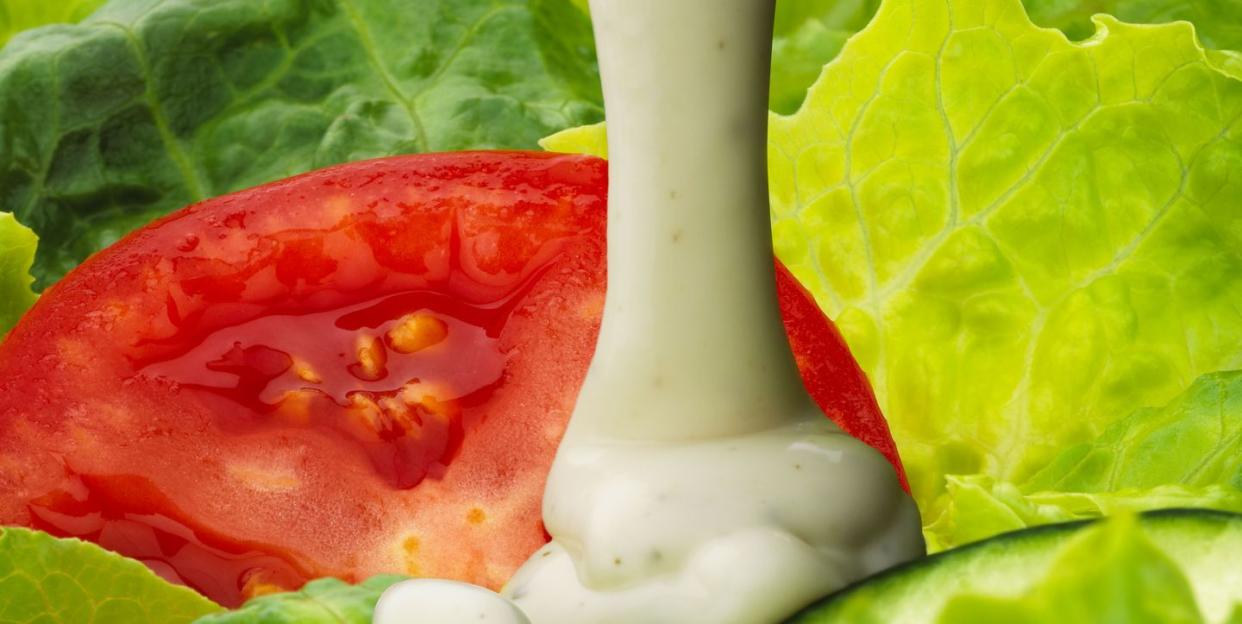How Bad Is Ranch Dressing for You, Really?

Whether it’s ranch, honey mustard, balsamic, or anything in between, chances are you top your salads and eat your veggies with some kind of dressing. But with so many varieties, you’re probably left wondering whether or not your favorite option is negating the benefits of your healthy meal or snack.
To find out, we turned to sports dietitian Lori Nedescu, M.S., R.D.N., founder of The Cadence Kitchen and author of the 30-Day Whole Foods Cookbook and Meal Plan.
The Claim:
Rich, creamy salad dressings are high in fat and calories, so you should avoid using them to top your salads with or dip your vegetables in. Instead, you should opt for vinaigrettes, which are less fatty and caloric.
The Evidence:
One serving-or 2 tablespoons-of Hidden Valley’s original ranch dressing contains 140 calories and 14 grams of fat, while one serving of Wish-Bone’s balsamic vinaigrette contains 60 calories and 5 grams of fat.
This is because the Wish-Bone vinaigrette’s main ingredients are water, balsamic vinegar, soybean oil, and extra virgin olive oil. Hidden Valley ranch, on the other hand, adds egg yolks and buttermilk to their list of main ingredients.
The Verdict:
While it may seem that you should avoid creamy dressings in favor of vinaigrettes, that’s not necessarily the case, according to Nedescu.
“What you’re mainly looking for in a salad dressing is to add flavor to vegetables,” she says. “So if [ranch or blue cheese] helps you eat those veggies, then go for it.”
[Build a killer midsection in the kitchen for powerful, effortless miles on the road with Eat for Abs!]
What about the low-fat stuff, though? Is that a good way to keep the creamy taste you love, but reduce the fat-and thus the calories, too?
Not exactly. Sure, low-fat or light dressing does have fewer calories than the original. Hidden Valley Fat-Free Ranch, for instance, contains 0 grams of fat and 30 calories per two-tablespoon serving size.
Problem is, if you’re not eating fats with your veggies, you aren’t absorbing fat-soluble vitamins (D, E, and K, for instance), says Nedescu. Any dressing that has a fat component is actually helping you reap performance-enhancing benefits of your produce, like boosting your bone health and reducing your risk of injuries.
Previous research backs this up: A study published in the Journal of the Academy of Nutrition and Dietetics found that adding monounsaturated fat to a meal helps your body absorb vitamin D. Additionally, a study published in the the American Journal of Clinical Nutrition found that added soybean oil (found in many types of dressings) aids in the absorption of not only vitamin D, but also beta carotene, lutein, lycopene, and vitamins E and K as well.
Fat also helps you to feel fuller longer, so you’re less likely to overeat throughout the course of your day-a vital component to keeping your weight at a healthy level.
However, Nedescu cautions that it’s important to watch out for flavor-enhancing additives like high fructose corn syrup, which aren’t the best for you. (This is especially true when it comes to low-calorie or fat-free dressings.) To be on the safe side, she recommends making your own dressings, which can be tailored to your specific tastes.
“Just start experimenting,” Nedescu says. “There are so many different varieties of oils and vinegars-which all help stabilize glucose levels and control hunger levels-and you can blend them with herbs and spices like chipotle or jalapeño.”
If you prefer something on the creamier side, she recommends adding a pasteurized egg into the mix-which also boosts the amount of protein you’re getting.
The bottom line? If you like creamier dressings, don’t worry about cutting them out of your diet. While they are more caloric, using them in moderation-no, you shouldn’t drench your salad in ranch, but there’s no harm in sticking to the two-tablespoon serving size- is a great way to make salads and vegetables tastier.
('You Might Also Like',)

